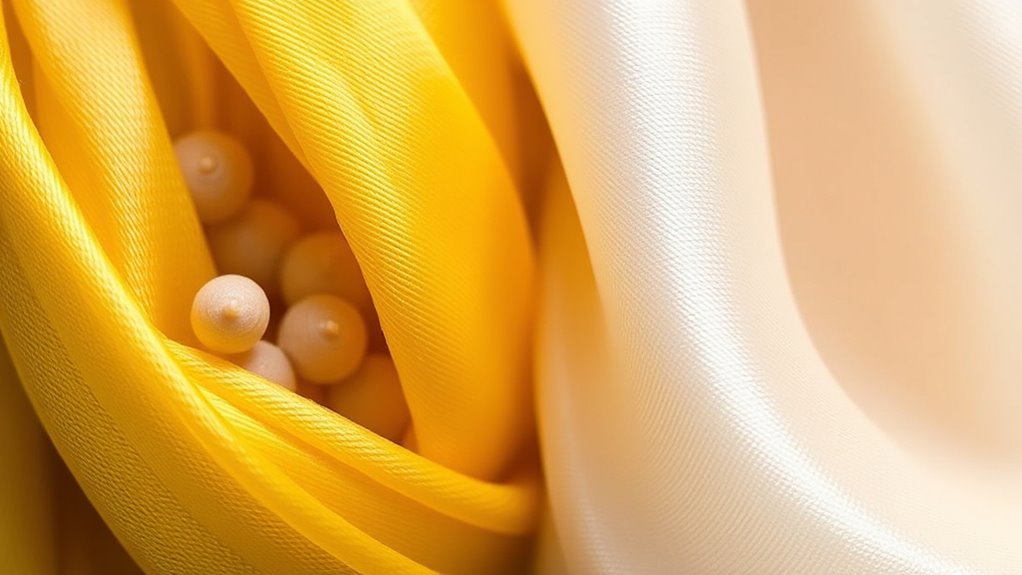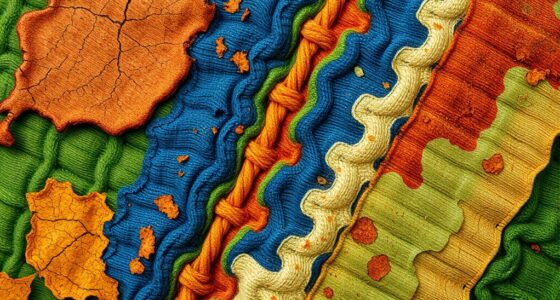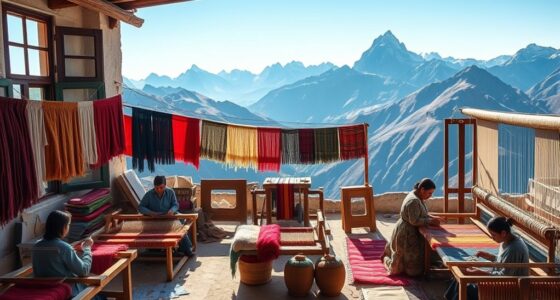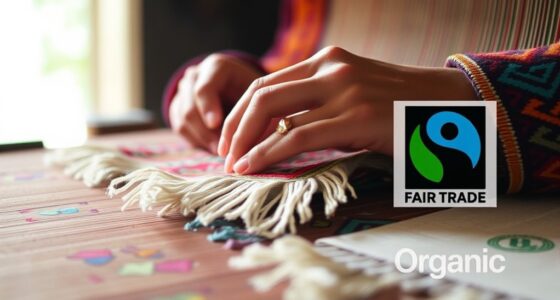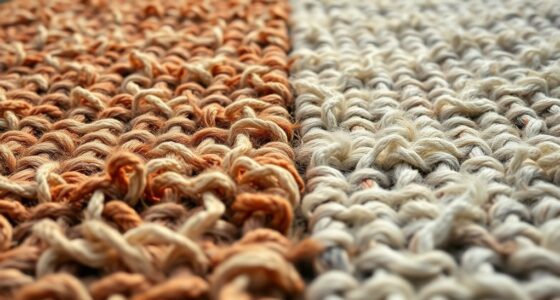When choosing between peace silk and conventional silk, you’re opting for different ethical practices and environmental impacts. Peace silk allows silkworms to naturally emerge from their cocoons, promoting humane treatment and reducing harm to ecosystems, while conventional silk involves boiling cocoons, often killing the worms. Although peace silk may cost more, it offers a richer, natural texture. To understand more about their differences, including cultural significance and future trends, keep exploring these sustainable options.
Key Takeaways
- Peace silk is produced without killing silkworms, ensuring humane treatment, unlike conventional silk which involves boiling cocoons.
- Ethical silk uses biodegradable dyes and sustainable practices, reducing environmental impact compared to traditional silk dyeing methods.
- Peace silk maintains high fiber quality and natural luster while supporting biodiversity and animal welfare.
- Conventional silk production is more cost-effective and widely accessible due to established supply chains, but it raises animal and environmental concerns.
- Growing industry trends favor sustainable, responsible practices, making peace silk a more ethical choice for eco-conscious consumers.
The Process of Traditional Silk Production
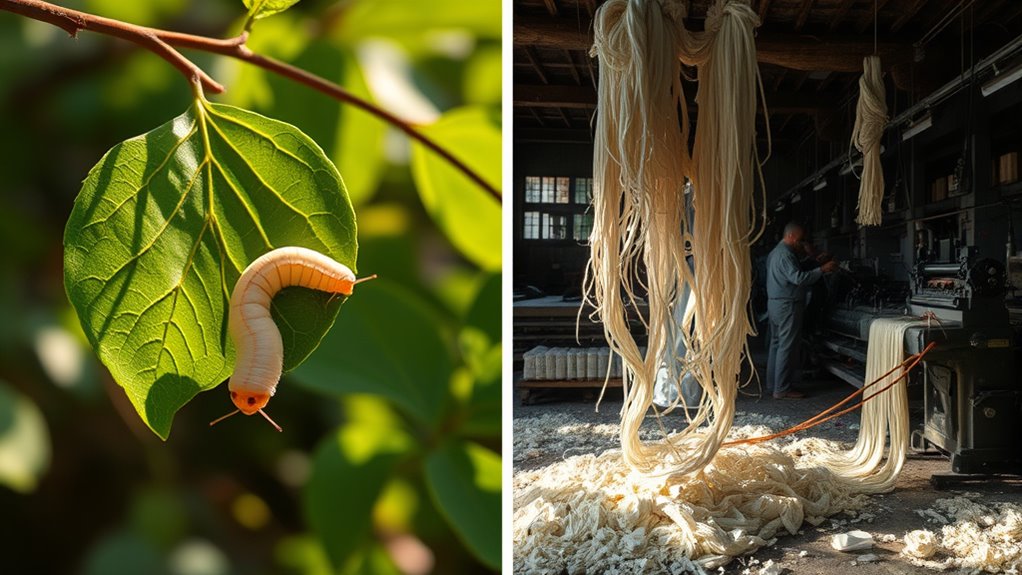
Have you ever wondered how traditional silk is made? The process begins with harvesting silk fibers from silkworm cocoons, which are carefully boiled to soften the threads. Once collected, the fibers are spun into silk yarn through silk weaving, creating beautiful fabrics. Traditional dyeing techniques are then used to add vibrant colors, often involving natural dyes derived from plants and minerals. These methods have been passed down through generations, emphasizing craftsmanship and sustainability. The entire process is labor-intensive and requires skill, ensuring each piece of silk is unique. Unlike modern synthetic methods, traditional silk production respects the natural lifecycle of silkworms and minimizes environmental impact. This method exemplifies cultural heritage and sustainable practices in textile creation, with ethical considerations playing a crucial role in preserving traditional practices. Additionally, sustainability is a core aspect that distinguishes peace silk from conventional silk, as it often involves harvesting silk without harming the silkworms or disrupting their natural environment.
How Peace Silk Is Made
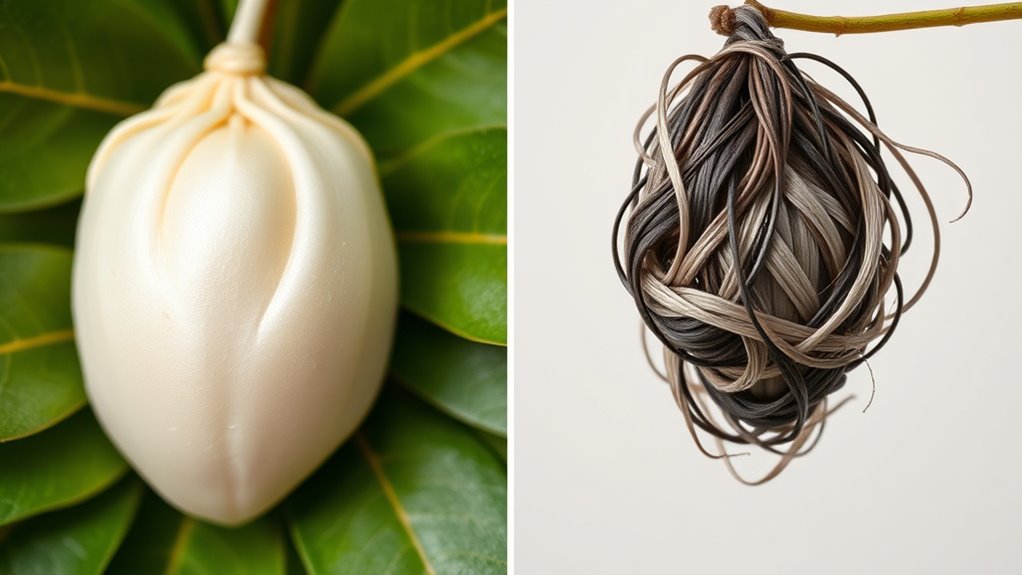
Peace silk is made through a process called sericulture without killing the silkworms, allowing them to complete their natural lifecycle. Instead of boiling the cocoons, farmers harvest the silk after the worms have emerged, ensuring ethical treatment. This approach lets you enjoy silk that’s produced with compassion and respect for the insects. Additionally, ethical sourcing ensures that the production process aligns with humane practices and sustainable principles. By prioritizing sustainable practices, producers support both environmental health and animal welfare. The growing awareness of animal welfare concerns in textile production encourages more companies to adopt these humane methods. Moreover, adopting ethical silk practices can help reduce environmental impact and promote biodiversity. Implementing these methods also aligns with regulatory frameworks, fostering trust and transparency in sustainable textile manufacturing.
Sericulture Without Killing
Sericulture without killing involves a gentle approach that allows silkworms to produce silk without being harmed. Instead of boiling cocoons, farmers wait for the silkworms to mature and emerge naturally, creating what’s called Peace Silk. This method respects the worms’ life cycle and promotes humane labor practices. During this process, artisans often use biodegradable dyes, reducing environmental impact. The method ensures the silk is eco-friendly from start to finish. Here’s a quick comparison:
| Aspect | Conventional Silk | Peace Silk |
|---|---|---|
| Killing the worms | Yes | No |
| Environmental impact | Higher (due to chemicals, dyes) | Lower (biodegradable dyes) |
| Labor practices | Often exploitative | Ethical and humane |
| Sustainability | Less sustainable | More sustainable |
Harvesting Ethical Silk
How is ethical silk harvested without harming the silkworms? Instead of boiling cocoons, you gently wait for the silkworms to naturally emerge, allowing the cocoon to be collected intact. This process maintains the silk fiber’s durability because the fibers are less processed and not subjected to harsh boiling methods. Since the silkworm isn’t killed, the silk retains better dye absorption properties, resulting in richer, more vibrant colors. The fibers often have a more natural, slightly textured feel, making them ideal for eco-conscious fashion. By harvesting in this gentle way, you preserve the integrity of the silk, ensuring it’s both sustainable and ethically produced, while still offering the strength and beauty you expect from high-quality silk. Additionally, sustainable practices in silk production are increasingly gaining popularity among environmentally conscious consumers. Incorporating ethical harvesting methods can further enhance the environmental benefits of peace silk, as it minimizes environmental impact and promotes animal welfare, making it an even more attractive option for conscious shoppers. Moreover, adopting AI-driven innovations in silk production can help optimize resource use and reduce waste, further supporting sustainability efforts.
Ethical Considerations in Silkworm Rearing
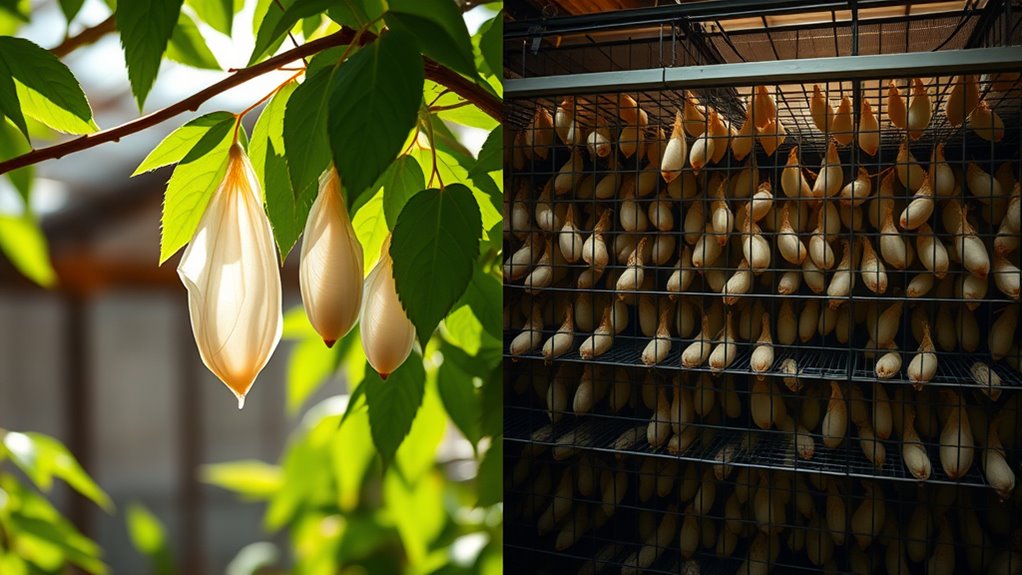
As you consider the ethics of silkworm rearing, it becomes essential to evaluate the welfare of the insects involved. Ethical silkworm rearing respects their natural behaviors and avoids unnecessary harm. When practicing silk dyeing and silk weaving, guarantee the silkworms are not subjected to forceful harvesting. Key considerations include:
Prioritize silkworm welfare by respecting natural behaviors and avoiding forceful harvesting.
- Providing a humane environment that minimizes stress and suffering.
- Allowing silkworms to complete their life cycle naturally, especially in peace silk methods.
- Avoiding the destruction of cocoons that contain live pupae, which raises ethical concerns.
Environmental Impact of Conventional Silk
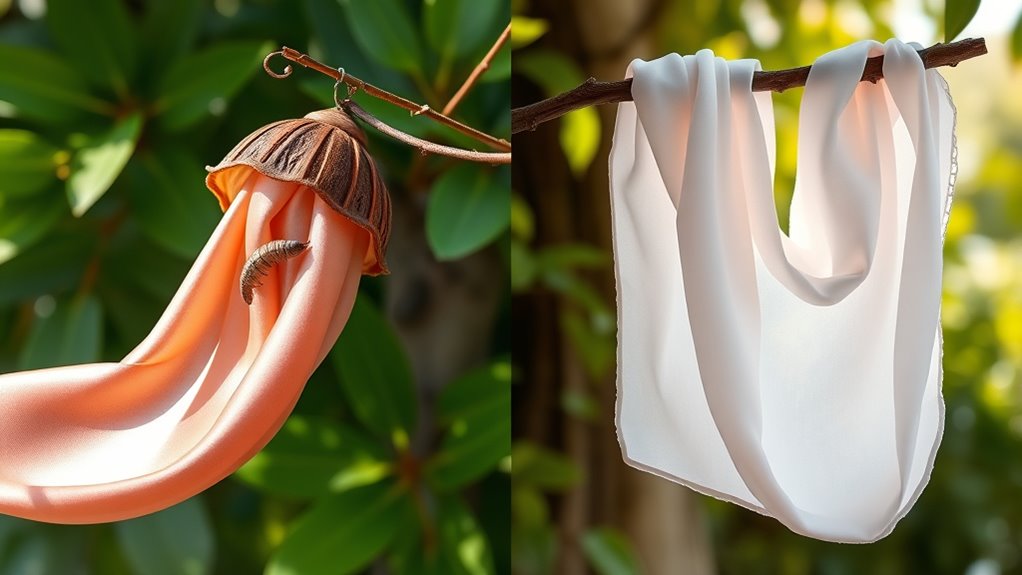
Conventional silk production generates significant waste that can harm local ecosystems. It also consumes large amounts of water and energy, putting strain on natural resources. Understanding these impacts helps you see why more sustainable options are gaining importance. Additionally, the environmental footprint of traditional silk can be reduced through innovative climate control and eco-friendly practices. Recognizing the history of silk highlights how traditional methods have contributed to these environmental challenges. Proper installation and venting are essential for reducing emissions and minimizing environmental harm associated with silk production.
Sericulture Waste Production
Sericulture, the process of producing silk, generates significant amounts of waste that impact the environment. This sericulture waste includes leftover silkworm cocoons, pupae, and mulberry leaves, which often end up in landfills or water systems, causing pollution. The disposal methods can harm local ecosystems and contribute to greenhouse gas emissions. Additionally, dyeing sustainability is affected because waste dyes and chemicals from conventional silk processing pollute waterways. To reduce environmental harm, some producers burn waste or use it for animal feed, but these methods can still be problematic. Furthermore, improper waste disposal can lead to environmental contamination, adversely affecting soil and water quality, and posing risks to biodiversity and local communities. Incorporating sustainable waste management practices can help mitigate these negative impacts and promote more eco-friendly silk production. Adopting innovative waste reduction techniques can further enhance the sustainability of sericulture.
Water and Energy Use
The production of silk demands large amounts of water and energy, leading to significant environmental impacts. Conventional silk involves intensive dyeing methods that require extensive water use and energy, increasing pollution and resource depletion. Fiber durability varies; while silk is strong, repeated dyeing can weaken fibers over time. To visualize the impact:
| Water Usage | Energy Consumption | Environmental Effect |
|---|---|---|
| High during dyeing | High during processing | Water pollution from dyes |
| Wastewater concerns | Carbon emissions from energy | Ecosystem damage |
| Repeated dyeing affects fiber strength | Energy-intensive mulberry cultivation | Long-term sustainability issues |
These factors highlight the heavy environmental footprint of conventional silk, especially regarding water and energy use.
Environmental Benefits of Peace Silk
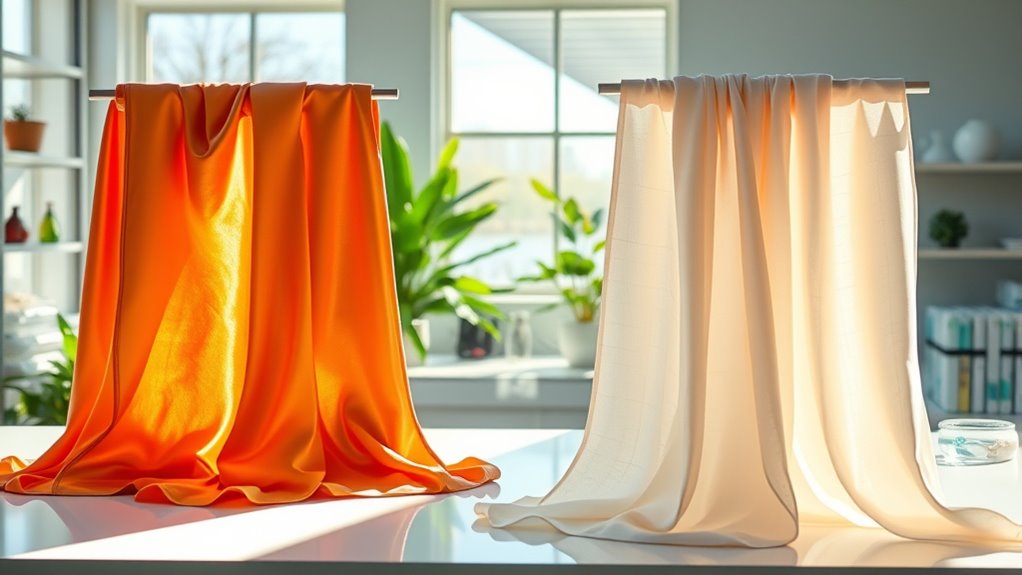
Because peace silk is produced without killing silkworms, it considerably reduces the environmental impact associated with traditional silk manufacturing. This method promotes eco-friendly dyes, which are less toxic and require fewer chemicals, minimizing water pollution. Additionally, peace silk often involves organic farm practices, avoiding harmful pesticides and synthetic fertilizers that harm ecosystems.
Peace silk reduces environmental harm by avoiding silkworm harm, using eco-friendly dyes, and supporting organic farming practices.
Here are three key environmental benefits:
- Reduced water and chemical use, lowering pollution.
- Support for organic farming, preserving soil health.
- Less energy consumption due to simpler processing methods.
Comparing Quality and Appearance
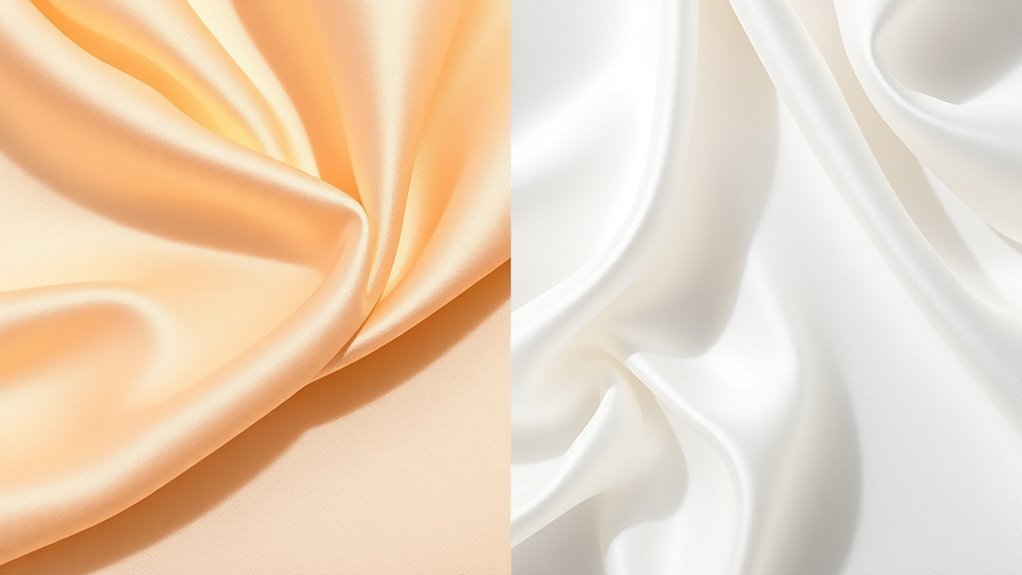
When comparing quality and appearance, peace silk often stands out for its softer texture and natural luster, which closely resemble traditional silk. Its dyeing techniques typically involve gentler processes, helping the fabric retain vibrant, rich colors without harsh chemicals. This results in better colorfastness properties, meaning the colors stay vivid longer and resist fading after washing. Conventional silk, on the other hand, may have a slightly shinier surface and more uniform finish due to different processing and dyeing methods. However, peace silk’s more organic feel and subtle sheen appeal to those seeking a natural aesthetic. Overall, while both types exhibit high-quality qualities, peace silk offers a softer touch and durable coloration that enhances its appearance, making it a compelling choice for ethically conscious consumers.
Cost and Accessibility of Both Types of Silk
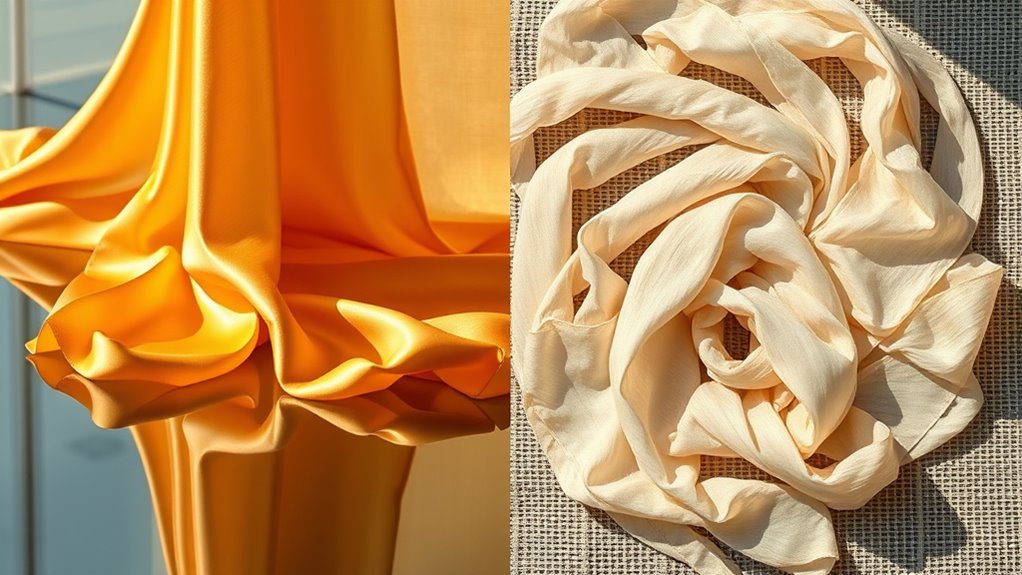
You’ll notice that ethical silk often has higher production costs due to more sustainable practices, which can make it less accessible. Market availability also varies depending on where you look, affecting how easily you can find different types. Overall, the price differences influence how widely each type is used and who can afford them.
Production Cost Differences
Producing traditional silk involves high costs due to the labor-intensive process of raising silkworms and harvesting the delicate fibers, which can make it expensive and less accessible for many. These costs impact the economic implications and supply chain dynamics of silk production. Specifically:
- The intensive labor increases labor expenses, raising overall production costs.
- Longer production cycles for conventional silk limit supply, affecting availability.
- The complexity of harvesting and processing adds to expenses, making it less affordable for some markets.
In contrast, Peace Silk often involves simpler or less resource-intensive methods, reducing costs. As a result, conventional silk’s higher production costs influence its pricing and accessibility, shaping market dynamics and economic implications for producers and consumers alike.
Market Availability Factors
Have you ever considered how the costs and production methods of silk influence its availability in the market? Market accessibility depends heavily on the supply chain, which varies between peace silk and conventional silk. Conventional silk benefits from a well-established supply chain, making it widely available and easier to find in most stores. In contrast, peace silk’s supply chain is often smaller and less developed, limiting its market accessibility. Ethical considerations and production complexity can also restrict the availability of peace silk, as it requires more careful sourcing and handling. These factors impact how easily consumers can access different types of silk, with conventional silk generally more readily available due to its extensive supply network. Understanding these supply chain dynamics helps explain the differences in market availability between the two silk types.
Price Variations Overall
Why do silk prices vary so much between different types? The main reason is pricing disparities driven by production methods and market accessibility. Peace silk, made without harming silkworms, often costs more because it requires careful, labor-intensive processes. Conventional silk benefits from large-scale production, lowering costs for consumers. Here’s what influences the price differences:
- Production costs—peace silk’s ethical practices increase expenses.
- Supply and demand—conventional silk’s higher availability reduces prices.
- Market accessibility—conventional silk is more widespread, making it easier to find and more affordable.
Consumer Awareness and Ethical Choices
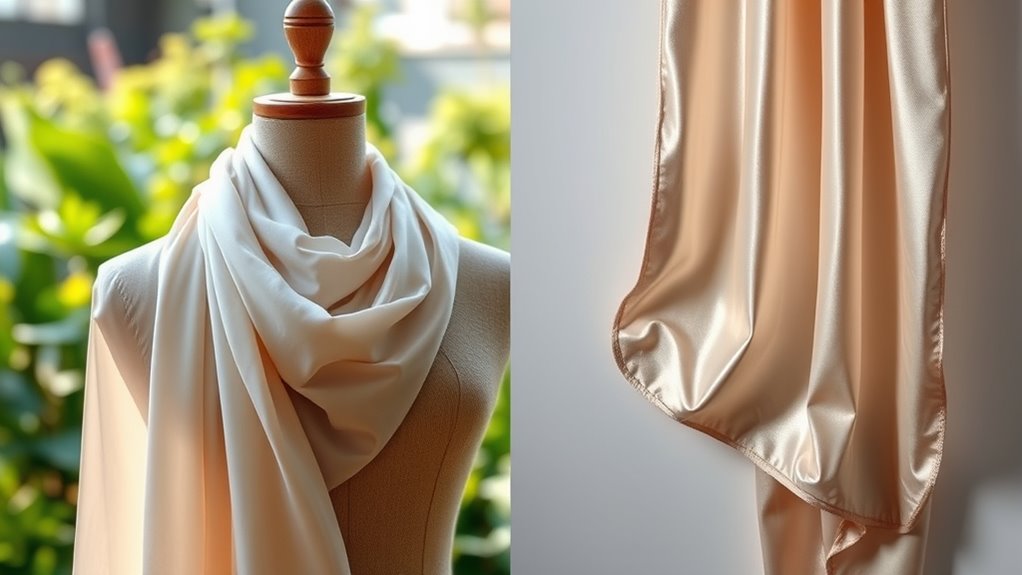
Are you aware of the ethical implications behind the silk products you buy? Consumer awareness plays a vital role in making ethical choices. By understanding the differences between conventional and peace silk, you can prioritize animal welfare and support more humane practices. Conventional silk production often involves boiling silkworms alive, raising ethical concerns. In contrast, peace silk allows silkworms to complete their natural life cycle, aligning with compassionate values. Transparency from brands helps you identify ethical options, so look for labels that specify cruelty-free or peace silk. Educating yourself about these practices empowers you to make informed decisions and advocate for better treatment of animals. Your choices can influence industry standards, encouraging more sustainable and humane silk production methods.
The Cultural Significance of Silk in Different Regions
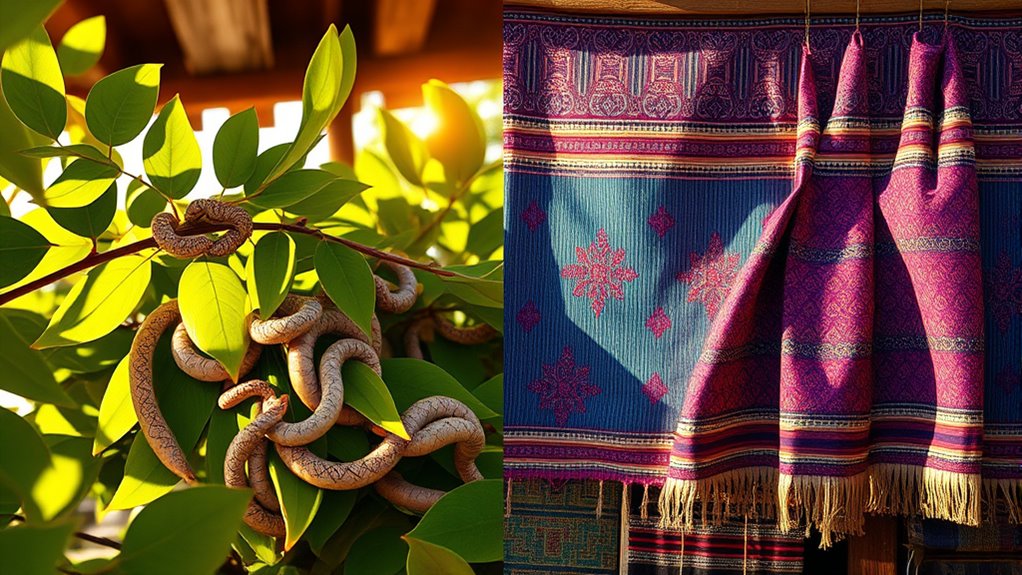
Silk has long held a profound cultural significance across various regions, shaping traditions, social status, and artistic expression. In China, silk symbolizes wealth and is central to traditional ceremonies. In India, it represents purity and is essential for wedding garments. In Europe, silk became a symbol of luxury and social distinction.
- Chinese silk is linked to cultural traditions like the Dragon Boat Festival.
- Indian silk signifies regional symbolism, especially in bridal attire.
- European silk reflects societal status and artistic craftsmanship.
Understanding these cultural traditions helps you appreciate silk’s role beyond fabric, as a essential part of regional identity. Whether used in ceremonies or as a status symbol, silk’s cultural significance remains deeply rooted in history.
Future Trends in Sustainable and Ethical Textiles

As consumers become increasingly conscious of environmental and ethical issues, the textile industry is shifting toward sustainable practices and responsible sourcing. Future trends focus on innovative dyeing techniques that reduce water use and eliminate harmful chemicals, making processes safer for workers and ecosystems. Textile innovation plays a pivotal role, with advancements like bio-based fibers, recycled materials, and plant-based dyes gaining popularity. These developments help lower carbon footprints and promote circular economies. You’ll see brands adopting transparent supply chains and eco-friendly certifications, reflecting a commitment to ethical sourcing. As technology evolves, sustainable textiles will become more accessible and affordable, encouraging consumers to choose eco-conscious options. This shift will reshape the fashion landscape, aligning style with sustainability and ethical responsibility.
Frequently Asked Questions
How Does Peace Silk Affect Traditional Silk Industry Workers?
You might wonder how peace silk impacts traditional silk industry workers. It can lead to industry transformation by offering alternative livelihoods and encouraging ethical practices. Workers may face challenges shifting to new roles or adapting to changing demand. However, peace silk aims to improve worker livelihoods by promoting humane and sustainable methods, which could ultimately benefit workers in the long run. Adaptation and support are key to easing this industry shift.
Are There Certifications for Ethically Produced Silk?
You might wonder if there are certifications for ethically produced silk. Certification standards like GOTS or Fair Trade guarantee that silk is ethically sourced, covering aspects like fair wages and animal welfare. Ethical labelling helps you identify products made responsibly, giving you confidence in your choices. By choosing silk with these certifications, you support sustainable practices and promote better conditions for workers and silkworms alike.
What Are the Challenges in Scaling Peace Silk Production?
Imagine trying to grow a delicate garden on rocky soil—that’s what scaling peace silk production feels like. You face challenges in maintaining sustainable farming practices and ensuring labor rights, which often increase costs and complexity. As demand for ethically made products grows, balancing the need for larger production with these ethical considerations becomes tough. You might find that expanding peace silk requires more patience, innovation, and commitment to uphold its moral values.
How Do Consumer Perceptions Influence Ethical Silk Adoption?
Your perception of ethical silk substantially impacts its adoption. When you’re aware of the benefits of peace silk and see strong ethical branding, you’re more likely to choose it over conventional options. Consumer awareness drives demand, encouraging brands to prioritize ethical practices. As more people value transparency and sustainability, ethical silk gains popularity, fostering a shift towards more compassionate and environmentally friendly fashion choices that align with your values.
Can Peace Silk Be Dyed and Processed Like Conventional Silk?
Imagine vibrant colors dancing on delicate silk threads—yes, peace silk can be dyed and processed much like conventional silk. When you explore silk dyeing, you’ll find that peace silk responds beautifully to the same dyes, yielding rich hues. Silk processing remains similar, maintaining its softness and sheen. So, you can enjoy eco-friendly peace silk without sacrificing the vibrant colors and luxurious texture you love in traditional silk.
Conclusion
Choosing peace silk over conventional silk means embracing ethics, protecting the environment, and honoring cultural traditions. It’s about making mindful decisions that respect life, preserve ecosystems, and support sustainable practices. When you opt for peace silk, you’re weaving compassion into every thread, nurturing a future where beauty and ethics intertwine. Ultimately, your choice can inspire change, promote kindness, and create a more sustainable world—one gentle, ethical fiber at a time.
